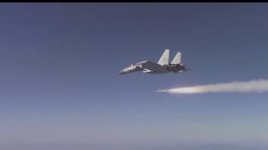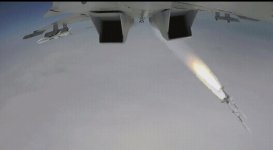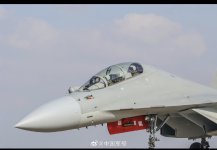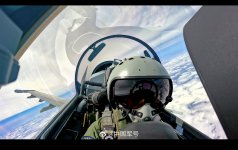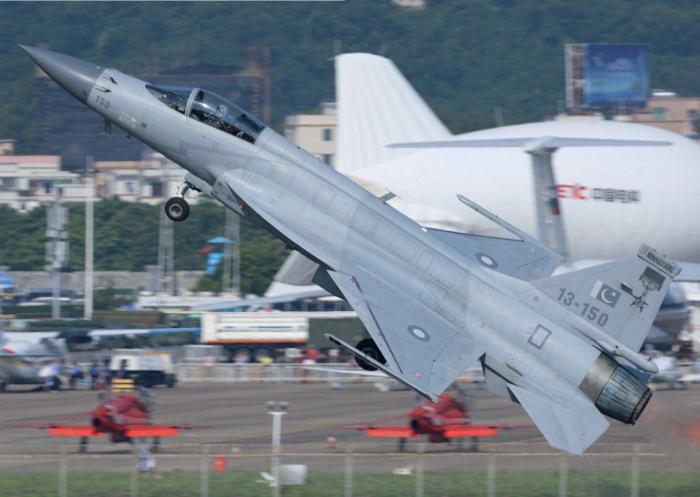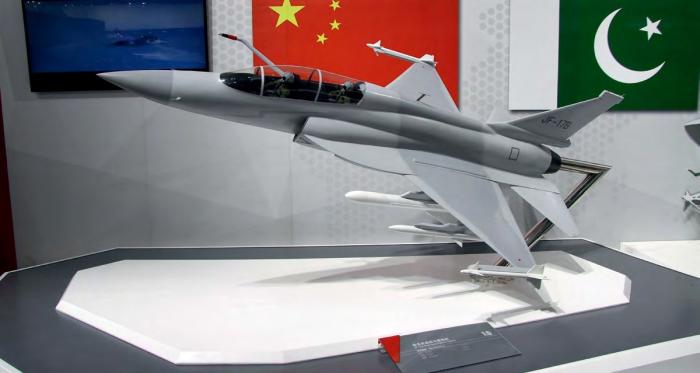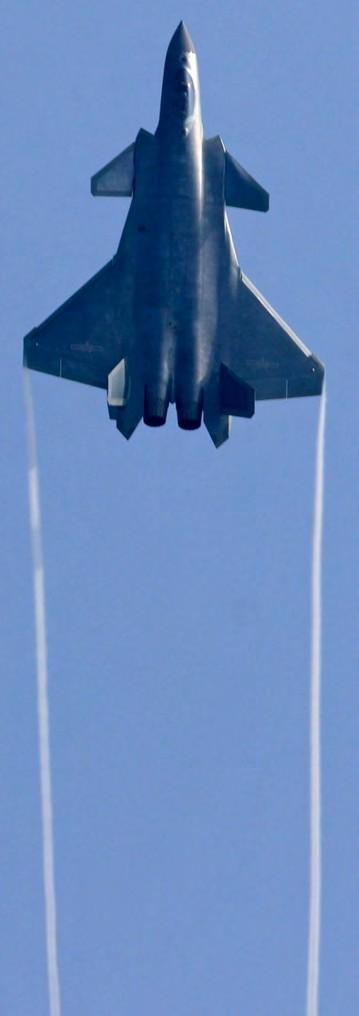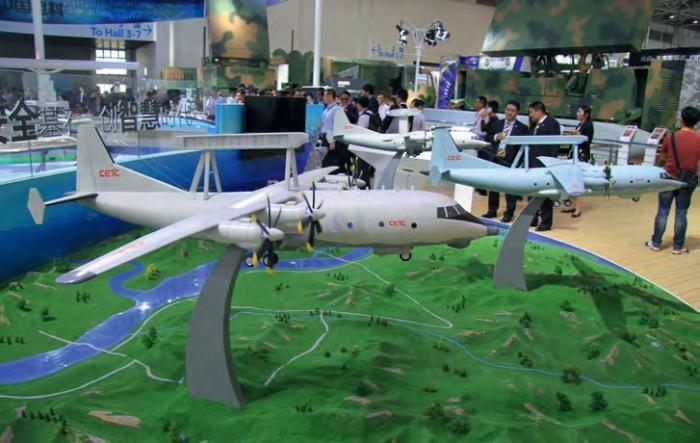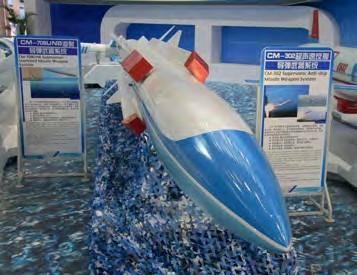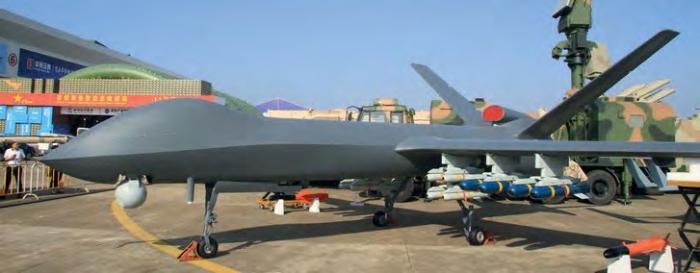CHINA SHOWS OFF
- Aviation Features
- China Shows Off
15th December 2016
FEATURE
The Pakistan Air Force Chengdu JF-17 always departed from the opposite end of the runway to other aircraft participating in the flying display. It meant the crowd could see the breathtaking departure. Sqn Ldr Zeeshan (seen here) and Wg Cdr Yasir took it in turns to pilot the aircraft during its daily ten-minute slot.
All photos, Alan Warnes
AFM’s Alan Warnes was the only British aviation journalist to travel to Air Show China 2016, where he found the country’s aerospace industry keen to show its technological expertise – and watched in awe as the Chengdu J-20 made its public debut.
AIR SHOW CHINA 2016
I HADN’T ATTENDED the biennial Air Show China at Zhuhai in Guangdong Province since 2000, but many at this year’s – the 11th China International Aviation and Aerospace Exhibition – described it as the best.
Undoubtedly the largest arms exhibition in Asia, the event, from November 1 to 6, appeared to have spared no expense in showcasing China’s aerospace capabilities as it strives to export more. With an impressive selection of aircraft, helicopters, munitions and avionics, most of which were available for export, you had all the ingredients for a superb show.
And so it was. It kicked off with the top-secret Chengdu J-20, making its public debut at the opening day ceremony, showing the world and the military dignitaries present what it can do.
Two of these futuristic-looking jets made a formation fly-by before one broke away to put on a display – which lasted only a minute. It was short but sweet.
The J-20 has been shrouded in secrecy since the prototype made its first flight on January 11, 2011. There are believed to be 18 currently flying – seven prototypes and 11 low-rate initial production (LRIP) jets. But there’s no drip, drip of press releases and briefings like the F-35 Lightning II, the West’s fifth-generation fighter it’s emulating.
Working together
AVIC (Aviation Industry Corporation of China) and CATIC (China National Aero- Technology and Export Exhibition) work closely together to market the portfolio of products displayed, and the J-20 will join them, perhaps as early as next year, when a 1:1 model will be used to show it off.
The Chinese are not traditionally open to answering questions: they try their best but they struggle. I sensed, with the younger generation, that they’re trying to be more open but were not too sure where the boundary of candour and concealment lay.
There were nine halls. Seven were in one big area, which you simply walked through. The biggest exhibition was, not surprisingly, by AVIC which displayed all its latest systems including a 1:1 scale model of its other new fighter project, the J-31 Gyrfalcon, at the entrance.
There were civilian aircraft as well as models of all the latest fighters, including the new dual-seat JF-17B – plus AWACS, UAVs, SAMs, radars and, of course, weapons.
One of the star exhibits was the new Harbin Z-19E attack/reconnaissance helicopter, an improved version of the Harbin Z-9, itself a licensed variant of the AS565 Panther. It was displayed with various weapons, including a quad-launcher equipped with four Blue Arrow 7 (export version of HJ-10) anti-armour missiles and an 18-barrel machine gun was on the starboard side.
Another exciting new project is the JF-17B Thunder. The prototype is expected to make its first flight at Chengdu in early 2017. Having its own dual-seater will enable CATIC to speed up weapons integration work for the Pakistan Air Force and other overseas customers.
The new Harbin Z-19E attack/reconnaissance helicopter. The export version is designated the WZ-19E but in common with most Chinese attack helicopters, none have so far been sold overseas.
Other weaponry around the helicopter included the new AG300/M air-to-ground missile. Alongside was a CAIC (Changhe Aircraft Industries Corporation) Z-11WB Kuang (Buzzard) scout helicopter, based on the civilian Z-11, which looks like the AS350B Ecureuil. It displayed with a plethora of weapons, such as the Norinco LG-3 automatic grenade launcher and a six-barrel machine gun.
Missiles included a quad-launcher equipped with four TL-2 (Tian Lei 2) air-to-surface missiles on the port side and an AG-300/M air-to-ground missile with a SW-6 air deployable tactical UAV on the starboard.
In front of the helicopter was a TY-90 air-to-air missile, CM-502KG air-to-surface missile, Red Arrow 8 (export version of HJ-8) and Blue Arrow 7 anti-armour missiles as well as FT-9 and YZ-212D laser-guided precision bombs.
Chinese police services are said to be interested in the Z-11WB which made its first flight in Jingdezhen, home of CAIC, on September 28 last year.
AVIC was showcasing four new missiles: the TL-17 is a 1,565lb (710kg) TV/infrared mediumrange air-to-ground missile that can be employed by fighter/fighter-bombers. It’s also been configured with an active radar seeker for the anti-shipping role, designated the TL-7.
The air-to-ship version is the TL-7A, the TL-7B is a shore-to-ship missile and a ship-to-ship variant the TL-7C. The weapon’s turbojet engine solid rocket booster powers the missile to Mach 0.85, cruising just above the sea surface.
The TL-20 bomb, with a strap-on extended range kit, weighs 220lb (100kg) and with its folding wings can travel 50 miles (85km). It can be used by fixed-wing aircraft and UAVs and, guided by both GPS and semiactive laser, reaches speeds of up to Mach 0.9. Used to strike fixed tactical targets, its brochure says it can also hit mobile vehicles.
The YJ-9E meanwhile is classed as a small multi-function missile for fixed-wing aircraft, helicopters, UAVs, ships and vehicles. Among its target sets are small surface ships, buildings and armoured vehicles.
With a mass of 231lb (105kg) and length of 8.5ft (2.6m), it can fly at Mach 0.7 – with a range of 10 miles (16km) 16 miles (26km) on helicopters and fixed-wing or UAVs.
The biggest draw at Air Show China 2016 was the Chengdu J-20. It did not hang around for long, but this shy jet did enough to get the masses talking.
“Two of these futuristic-looking jets made a formation fly-by before one broke away to put on a flying display – which lasted only a minute. It was short but sweet.”
CETC
Moving into Hall 2, there was no missing the very busy China Electronics Technology Corporation (CETC) display. The CETC Wuhu Diamond Aircraft Manufacture Co Ltd, Diamond’s sole Chinese agent, founded in December 2013, was keen to demonstrate its burgeoning special mission aircraft capabilities, which revolved around the Diamond Da42MPP, a popular product in the West.
Exhibits included a model of a Da42 configured as the Sun Eagle mediumaltitude long endurance UAV, equipped with an EO/IR sensor and synthetic aperture radar (SAR). In the marketing handout was an unmanned and manned autogyro known as the CETC Sun Hawk, with the drone version equipped with a missile.
Also displayed was the strange-looking Mysterious Bee, a hybrid quadcopter drone that is equipped to carry various payloads, such as an aerial camera, EO/IR sensor and a miniature SAR. It was also fitted with radio comms equipment to support missions such as island/reef/border patrol, mountain reconnaissance and communications relay.
The most fascinating part of the CETC stand was the radar area, with a fullsize balance-beam casing on display, normally housing the JY-06 AESA radar. Three 1:20 scale AEW&C (Airborne Early Warning and Control) models were on display. Two were examples of the K/JE-03; a Shaanxi Y-9E with a balanced beam radar and the other was a KJ-500/ZDK-06. The latter is a Shaanxi Y-9E with a rotodome on top housing three JY-06 Active Electronically Scanned Array (AESA) radars, often referred to as active phased array in China. With three radars, each taking up a third of the rotodome, it doesn’t have to rotate.
CETC prides itself on merging early warning detection, surveillance, reconnaissance – as well as command and control – into airborne integrated electronic information systems. Its philosophy is to ‘find, fix, track, target, engage and assess’ by establishing an air-to-air/air-to-ground combat system to improve efficiency of the information extracted.
Among other exhibits, the KLC-11 airborne multifunctional surveillance radar, updated from the KLC-9 radar, is aimed at the international market. CETC claims its technical and general performance is comparable to similar foreign radars such as the AN/APY-8 (equipping the Predator drone), the marketing brief saying: “It has good platform adaptability and advantages in cost performance and competitiveness over rival systems in the international market.”
For the AEW&C role, CETC ran a video showing how capability improvements in the ZDK-06 have provided a more flexible means of attack and defence. Working with fighters, UAVs, navy ships and command centres, it can data-link the information it’s detecting over long ranges and vice-versa and can downlink the aerial picture as well as uplink data from ground-based air defences.
The ZDK-06 is said to offer midcourse guidance, updating a missile’s trajectory en route to a mobile target.
ZETC displayed two different Y-9 AEW&C aircraft. They included a KJ-500/ZDK-06 with a rotodome on top, while a real aircraft stood in the static (see last month). The other two models represented the same K/JE-03, with the balanced beam radar, but presented in different colour schemes.
Second J-31 prototype
A second J-31 prototype, PT-2, is expected to fly by the end of the year, according to CATIC. The new fighter is being built at Chengdu Aircraft Corporation and will incorporate several changes over the first prototype, PT-1, which flew at the Zhuhai show in 2014.
Improvements have been made to its aerodynamics and radar cross section (RCS), making it stealthier. There will also be a new avionics layout compared to the original cockpit – which could be seen in the AVIC stand, described as the ‘Advanced Avionics Concept’.
The new layout was going to be displayed at Zhuhai, but permission was denied in the lead up to the show. Changes include an IRST (infrared search and track) sensor under the nose – rather than shown on top as seen at the stand – and the cockpit will have digital back-up screens above the rectangular multifunction display.
The weapons bay of the second prototype will be larger than the first (which could house four legacy SD-10As), facilitating carriage of up to six SD-10A BVRAAMs with foldable fins. A second J-31 airframe has already been built for static rig tests.
The author’s source said the J-31 will have a Chinese engine (probably the WS- 13A) but could still use the Russian RD-93 used by the JF-17. An RD-93 was displayed at the United Engine Corporation stand. CETC offered the KLJ-7A AESA radar at its stand, which is being seen as the ‘brains’ of the J-31 and is also an option for the Pakistan Air Force’s Block 3 JF-17s.
The J-31’s flying performance at Zhuhai in 2014 attracted criticism when it was described as ‘flying like a brick’ with afterburners on – and many thought it was probably under-powered. But in response, a CATIC source told the author: “Generally us Chinese are more cautious with our prototypes than you are in the West, and that’s why the J-31 was flown the way it was.”
The jet is being primed mainly as an air defence fighter for the export market, but AVIC is optimistic the PLAAF and the People’s Liberation Army Navy (PLAN) will acquire it.



